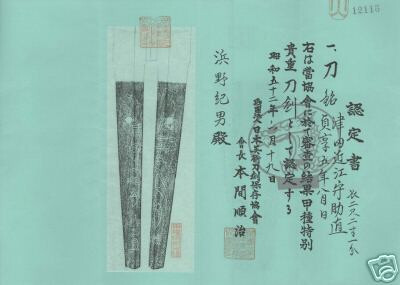-
Posts
4,164 -
Joined
-
Last visited
-
Days Won
31
Content Type
Profiles
Forums
Events
Store
Downloads
Gallery
Everything posted by Grey Doffin
-

WW2 Wakizashi? Thoughts? How to remove blade?
Grey Doffin replied to JustinJustin's topic in Nihonto
Hi Justin, The metal pin is 2 piece and either a friction fit (male & female halves) or threaded (either right or left hand thread). This could be fussy to take apart without doing damage. Where in The States do you live? Maybe we can put you in touch with someone who has dealt with one of these before. Mean time, here is a page with a care and handling brochure you would be smart to read: https://nbthk-ab2.org/sword-characteristics/ Looks like it could be a better than average sword. Go slow and get some educated help. Grey -
Hi Jay, You asked "What helped you determine it predates WWII?" 40 years of study:-) Pictures aren't going to tell us a lot; this needs to be seen in hand by someone who knows what he's looking at. Grey
-
Hi Jay, Your sword is older than WWII, sometime between mid 15th and late 19th centuries and hard to say much more without better pictures. Where in The States do you live? Maybe there is someone knowledgeable and honest nearby who can give you a better idea what you have. It needs to be seen by a properly trained polisher before you decide to have it restored. Mean time, here is a page with a care & handling brochure you should read: https://nbthk-ab2.org/sword-characteristics/ Grey
-
Hi Don, There is no way to know from your pictures how old the blade or the horimono are. If the hori were added to disguise a defect, the hori would be less old than the blade, something that could be true even if it wasn't added to disguise a defect (see ato-bori horimono). Grey
-
Hi Don, That is, I believe, a sanskrit character called Bonji. On the other side is a ken with something else I can't see clearly enough to identify in the middle. The placement of the something else is odd; it may have been carved there to hide a blister or other ugly defect in the blade. Grey
-
Thanks guys, No need for go fund, Stephen; we have insurance but appreciate the offer. I will be at the show in Chicago; wouldn't miss it. Cheers, Grey
-
Hi folks, As some of you know already, on January 27 I suffered a fire in my house (an electric radiant heat panel in the ceiling arced out). No one was injured but the house is a mess and we likely won't live in it again until this fall at the earliest. None of my swords, kodogu, or books were damaged. All the books, however, have been put into storage and won't be available until I can move home. The swords and fittings, on the other hand, I can get to. I'm keeping a list of customers who want books so I can get to them later; I'd love to deal with you on a katana or tsuba right now. If you find something at Japaneseswordbooksandtsuba.com that interests you, please let me know (contact me by email through the site). The phone # on my site is the land line and is currently dead. If you want to talk my cell is 218-340-1001. Thanks for all the support I've received from my friends in Nihonto, Grey
- 10 replies
-
- 19
-

-

-

-

Dealing with a tight shirasaya
Grey Doffin replied to Paz's topic in General Nihonto Related Discussion
If the habaki is firm in the saya and 2 fists next to each other and squeeze doesn't work, try the 2 fists next to each other behind your knees and hunker down. As you squat your knees will push on each other and force your fists apart. This problem is avoided if you are careful not to shove the blade too firmly into the saya. It is necessary only that the habaki be seated, not that it is all the way in; no problem if it leaves a small gap. Whenever I return home from a sword show, I check all blades to make sure none have been seated too firmly. If the nakago is too tight in the tsuka, use the hammer and block tool made for this. Grey -
I would call that ko-itame. Grey
-
Yep, San Gatsu, March. Grey
-
I believe this is Yoshimitsu and Showa Ju Hachi Nen Ni Gatsu (February of 1943). Grey
-
Hi Chris, Seki Mifuku Masayuki Saku, I believe. Grey
-
Steve, can I ask you where you found this information? I'm puzzling over this soemei with a friend who can read Japanese and he couldn't find reference to Tadatsuna's family name in his references. Thanks, Grey
-
Thank you Steve; now I understand. Grey
-
Interesting and thanks all. I found this on wikipedia: https://en.wikipedia.org/wiki/Azai_clan and this: https://en.wikipedia.org/wiki/Azai_Nagamasa Which leads to a question: if the Azai were obliterated by Nobunaga in the 16th century, can we assume Tadatsuna, who worked in the 17th century, was making the sword for a descendant who had no official position or did the remnants of the clan make a come back and reestablish importance? Grey
-
Hi Bruce, Unfortunately, Mr. Plimpton is not available for correspondence. I'm sure that when he acquired this sword he went with the information of the time and called it what he called it. Nothing more to add. Grey
-
Yes Bruce, a word for word quote. Grey
-
Hi guys, I, along with Mark Jones, Matt Jarrell, and Eric Molinier, purchased the Plimpton collection and have been selling it. This sword was in the collection but it wasn't sold on ebay by any of the 4 of us; it was sold some time back to a different sword dealer and he has placed it on ebay. We want all of you to know that when we are the sellers we will be honest in our descriptions and we will stand behind them. I think the sword's buyer should contact the seller and ask to return it. Although I am not responsible for this sale, I would like to mention that the seller may have been relying on John Plimpton's description of the sword in his soon to be published book: "ARMY NAVY LATE WAR. These swords were made near the very end of the war by the Tokugawa naval arsenal in Aichi Prefecture. Many of them have mixed army and navy fiittings. All of them have navy arsenal stamps, stainless steel blades, and black lacquer scabbards. In rare cases the tang is signed." Mr Plimpton has not been in good health and his description likely was written before modern research into the souvenir swords. That said, if the buyer is unhappy he should contact the seller; no honest seller wants dissatisfied buyers. Thanks, Grey
-
Hi guys, Harry Watson, in his translation of Nihonto Koza, says that Nidai Tadatsuna signed with "a soemei of Asai Uji on the ura". What does Asai Uji mean in English? Thanks, Grey
-

Tokubetsu Kincho Nintei-sho papers
Grey Doffin replied to kissakai's topic in General Nihonto Related Discussion
Hi Grev, There was the Koshu Tokubetsu Kicho paper (see below) that was a higher paper than Tokubetsu Kicho. Also, the 1st Juyo papers date to 1958, well before Kicho and higher were replaced by Hozon and higher. Grey -

Tokubetsu Kincho Nintei-sho papers
Grey Doffin replied to kissakai's topic in General Nihonto Related Discussion
If I understand the question: Tokubetsu Kicho are not on the same level as Juyo. I came to Nihonto about the time that the NBTHK made the change from Kicho and above to Hozon and above. At that time I was told that they were also upping their expectations to qualify for a paper: Hozon would roughly equal the old Tokubetsu Kicho and Tokubetsu Hozon would roughly equal the old Koshu Tokubetsu Kicho. Not all of the old papers are suspect. An old green paper to Muramasa or Masamune on a sword or Nobuiye or Kaneiye on a tsuba, say, are to be eyed suspiciously but, for less important artists, not so much. Grey -
Hi Dan, I don't plan to attend that one; sorry. Grey
-
Hi guys, I haven't posted here for a while; thought I should stir the pot. I just listed a lovely signed and papered katana with itomaki no dachi koshirae: all of it in excellent condition. https://www.japaneseswordbooksandtsuba.com/store/swords/q642-signed-papered-katana-itomaki-no-dachi-koshirae I know there have been newer collectors here on NMB asking about possible purchases. They could do a whole lot worse than this one. And as long as I'm tooting my horn, I don't understand why I still own this Hojoji Kunimasa katana: https://www.japaneseswordbooksandtsuba.com/store/swords/q404-long-katana-hojoji-kunimasa Give it a look. Cheers, Grey
-
With the understanding that I haven't seen the sword in hand (it may be wonderful) and also, since I do sell swords, I have a dog in this fight, I think you can do better for the money. 4,500 GBP is about US$6,150; I would expect something more exciting than unsigned Jumyo in shirasaya with a paper for that amount. Grey


